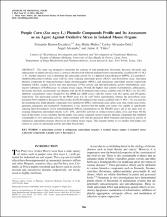Purple corn (Zea mays L.) phenolic compounds profile and Its assessment as an agent against oxidative stress in isolated mouse organs

View/Open
Trabajo
(application/pdf: 234.2Kb)
(application/pdf: 234.2Kb)
Date
2012-02Author(s)
Ramos-Escudero, Fernando
Muñoz, Ana María
Alvarado-Ortíz, Carlos
Alvarado, Ángel
Yáñez, Jaime A.
Metadata
Show full item recordAbstract
This study was designed to determine the contents of total polyphenols, flavonoids, flavonols, flavanols, and anthocyanins of purple corn (Zea mays L.) extracts obtained with different methanol:water concentrations, acidified with 1% HCl (1 N). Another objective was to determine the antioxidant activity by 1,1-diphenyl-2-picrylhydrazyl (DPPH), 2,2'-azinobis(3-ethylbenzothiazoline-6-sulfonic acid) (ABTS), ferric reducing antioxidant power (FRAP), and deoxyribose assay, individual phenolic compounds by high-performance liquid chromatography (HPLC), and endogenous antioxidant enzyme (superoxide dismutase [SOD], catalase [CAT], and total peroxidase [TPX]) activity and lipid peroxidation activity (thiobarbituric acid-reactive substances [TBARS] assay) in isolated mouse organs. Overall, the highest total content of polyphenols, anthocyanins, flavonoids, flavonols, and flavanols was obtained with the 80:20 methanol:water extract, acidified with 1% HCl (1 N). The 50% inhibitory concentration values obtained by the DPPH and ABTS assays with this extract were 66.3 μg/mL and 250 μg/mL, respectively. The antioxidant activity by the FRAP assay was 26.1 μM Trolox equivalents/g, whereas the deoxyribose assay presented 93.6% inhibition. Because of these results, the 80:20 methanol:water extract, acidified with 1% HCl (1 N), was used for the remaining tests. Eight phenolic compounds were identified by HPLC: chlorogenic acid, caffeic acid, rutin, ferulic acid, morin, quercetin, naringenin, and kaempferol. Furthermore, it was observed that the purple corn extract was capable of significantly reducing lipid peroxidation (lower malondialdehyde [MDA] concentrations by the TBARS assay) and at the same time increasing endogenous antioxidant enzyme (CAT, TPX, and SOD) activities in isolated mouse kidney, liver, and brain. On the basis of the results, it was concluded that the purple corn extract contained various bioactive phenolic compounds that exhibited considerable in vitro antioxidant activity, which correlated well with the decreased MDA formation and increase in activity of endogenous antioxidant enzymes observed in the isolated mouse organs. This warrants further in vivo studies with purple corn extracts to assess its antioxidant activity and other bioactivities.
Collections
- Artículos [274]
Publisher
Mary Ann Liebert
Rights
info:eu-repo/semantics/openAccess
Funding
Consejo Nacional de Ciencia, Tecnología e Innovación Tecnológica, proyecto (número PROCYT 331-2007).
Programa de Ciencia y Tecnología para la concesión de estudios de doctorado (número 124-2009-FINCyT-BDE).







